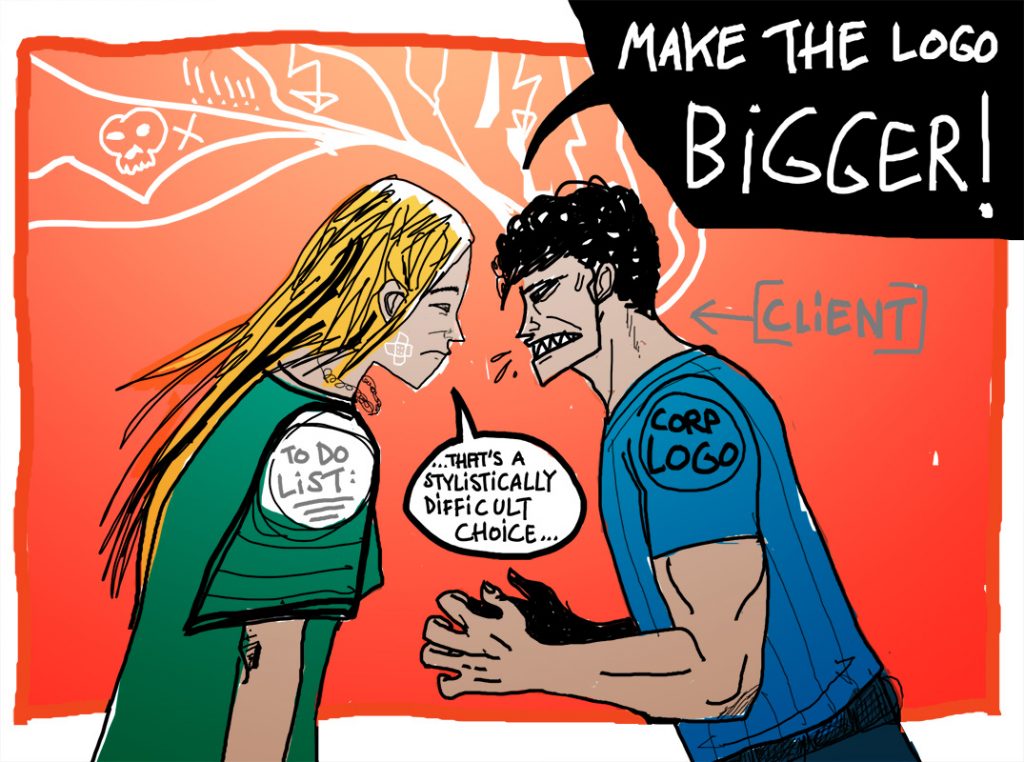
By Mars Dorian, {grow} Contributing Columnist
It’s an uncomfortable topic most of us never want to face, but let’s be real. Working with clients may eventually run you into trouble. We are unique individuals and carry different ideas, and when we don’t communicate them effectively, verbal crossfire ensues. I had my fair share of customer conflict, so I want to share the tips I’ve learned from my battles.
1) Work on a common goal and repeat it
You can save most client relationships from going southern sour by setting up a good agreement which clarifies your mutual goals. I start this process by asking specific questions:
What do you expect from me? What do you like about my art specifically?
Why do you think I’m the best for the job?
What do you think our collaboration can look like?
The goal is to agree on a common guideline which is as clear as a glass crystal in the azure sky. So when disagreements happen, (hint: they will) you can always point to your initial agreement and refocus. A common guideline in my illustration work can look like this:
We want to create a colorful artwork using your brand colors blue and yellow. The artwork features character X and character Y. It is supposed to ooze an upbeat, edgy vibe which is geared toward market (Z). It should look good both on a high-resolution wide screen and as a thumbnail on a smartphone.
It’s a basic approach, but you get the idea. The paragraph above puts our mutual ideas into words that act as the anchor of our ongoing collaboration. Whenever our visions diverge during the back and forth, we go back to this guideline. We remember our promise.
2) Double-down on decency
 In the early stages of my career, I often reacted in a passive-aggressive way when the client experienced troubles with my work. So when the client said something like “I don’t like that” or “That’s not what I expected.” I replied, “Well, that’s what you hired me for.” or “But that’s obviously my style.” Ugh. Pout alert.
In the early stages of my career, I often reacted in a passive-aggressive way when the client experienced troubles with my work. So when the client said something like “I don’t like that” or “That’s not what I expected.” I replied, “Well, that’s what you hired me for.” or “But that’s obviously my style.” Ugh. Pout alert.
Remember that most of our physical communication is based on gesture, tone, and attitude.
These nuances vanish with the written word, which can turn an innocuous sentence like “What do you want from me?” into a charged question. That’s why I always double-down on decency, making my statements sound at least twice as friendly as what might be in my head.
Listen, I’m a German hailing from the capital Berlin, which is known for its brash and blunt attitude. We even have a word for it: “Berliner Schnauze”, which roughly translates as Berlin’s snout, implying we talk like animals. But with the help of my friendly American colleagues, I quickly changed my answers.
“What do you want?” turned into “How can I help you?”
“This is a problem” changed into “How can we make this work?”
I use the ‘we’, ‘us’ and ‘our’ to imply collaboration. After all, we we’re working on this project together.
Even though I do the actual drawing/designing, it happens with the constant feedback of the client. A neat side effect of the nice ‘we’ approach is the shared responsibility. The client can no longer blame me alone for how a work turned out because we worked together on making it happening.
3) When visions divert, go back to basics
 I was in the middle of an advanced sketch which we had agreed on. I wanted to turn the sketch into the final artwork and receive my last ‘blessings’ from the client. He then criticized minimal aspects of the advanced sketch, such as the mimics and tone of the drawn characters, which I understood.
I was in the middle of an advanced sketch which we had agreed on. I wanted to turn the sketch into the final artwork and receive my last ‘blessings’ from the client. He then criticized minimal aspects of the advanced sketch, such as the mimics and tone of the drawn characters, which I understood.
I followed his feedback and changed the mimics and tone, which the client then criticized again, claiming it didn’t meet his vision. He then ditched the layout we had already agreed on and wanted to do something different, based on a new sketch he had drawn while I was busy preparing the final artwork.
At this point, I realized the client was never going to be satisfied with my style, as the feedback kept not only changing, but moving into the opposite direction.
I knew I had to disrupt the loop without hostility, so I reinstated our initial goals from point 1 in this post. I used the we form: “…we picked this sketch image because it represented our idea perfectly. The new sketch you propose is different from our agreed direction and could confuse the potential customer.”
See how I used words like ‘we’ and ‘our’ to stress the collaboration? In the ancient dark days, I would have hammered statements like “You said you wanted this (x) and now you say this (X)”. This approach would have made me sound like a whiny brat who accused the client of wrongdoing. Sad!
And yet, despite the amiable response, for a couple of days, our connection cooled. Online silence echoed from the client inbox. Tssss.
I was afraid I had angered the client, but he finally answered. He said he disagreed with my approach, but thanked me for my work so far and parted to look for a new illustrator.
Despite our conflict, we parted on amiable terms, which is the ideal result you want to achieve when there’s no chance of working together anymore.
Conclusion
We’re wired for collaboration, but since we’re all individuals crusading in the lands of the wild web, customer conflict is bound to happen.
If we avoid passive aggressive behavior and blame games, we can focus on our mutual agreements we have initially worked out together. And when the deal still goes down the creative pipe, we can part in peace.
Can you name a situation where you experienced trouble with customer conflict? If yes, how did you solve it?
 Mars Dorian draws funky illustrations and pens sci-fi thrillers for the Internet Generation. His latest novel is available on Amazon for just $2.99! Consider his artwork for your next project: http://www.marsdorian.com
Mars Dorian draws funky illustrations and pens sci-fi thrillers for the Internet Generation. His latest novel is available on Amazon for just $2.99! Consider his artwork for your next project: http://www.marsdorian.com
The post Three strategies to take the heat out of customer conflict appeared first on Schaefer Marketing Solutions: We Help Businesses {grow}.
from {grow} http://feeds.feedblitz.com/~/262886792/0/markgrow~Three-strategies-to-take-the-heat-out-of-customer-conflict/
No comments:
Post a Comment